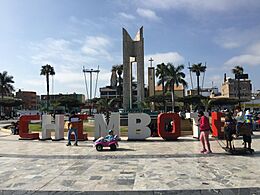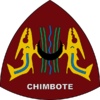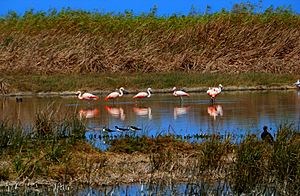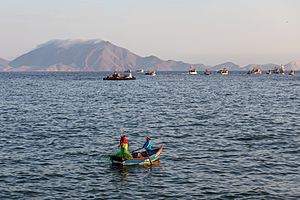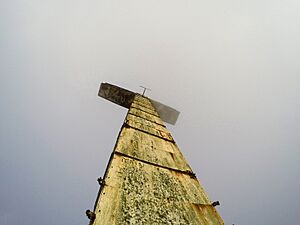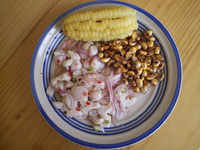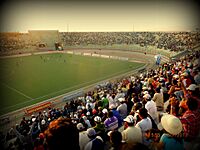Chimbote facts for kids
Quick facts for kids
Chimbote
|
|||
|---|---|---|---|
|
|||
| Nickname(s):
"The capital of fishing and steel"
|
|||
| Country | |||
| Region | Ancash | ||
| Province | Santa | ||
| Founded | 6 December 1906 | ||
| Elevation | 4 m (13 ft) | ||
| Population | |||
| • Estimate
(2015)
|
371,012 | ||
| • Density | 3,019/km2 (7,820/sq mi) | ||
| Time zone | UTC-5 | ||
| Area code(s) | 43 | ||
| Website | www.munisanta.gob.pe | ||
Chimbote (pronounced tʃimˈbote) is a big city in Peru. It's the largest city in the Ancash Region and the 10th biggest city in the whole country. About 425,367 people live here. Chimbote is the main city of both Santa Province and Chimbote District.
The city is on the coast, right on Ferrol Bay. It's about 130 km south of Trujillo and 420 km north of Lima. You can reach it easily by the North Pan-American highway. Chimbote is important because it's at the start of a line of major cities along Peru's northern coast. Its location also makes it a key place for moving goods from the Santa River valley.
Contents
What's in a Name?
The name Chimbote might come from the Quechuan languages. Some journalists in 1969 suggested it comes from the Quechua word "chimba," which means 'to cross a river' in the local Ancashino Quechua language.
Chimbote's Story
Ancient Times
The land where Chimbote is today was once home to several ancient cultures. These included the Recuay, Moche, Wari, Chimor, and Inca cultures. You can still see signs of them at places like Huaca San Pedro. It's believed that the same group of people, the Maya, lived here for a long time. However, they were scattered and their numbers dropped when the Conquest of America happened.
Colonial Days
The name Chimbote first appeared in an official document in 1774. This document mentioned that the old town of Santa María de la Parrilla (Santa) had a small fishing village called Chimbote nearby. The first people to settle here were fishermen from a place called Huanchaco, near Trujillo. That's why they were sometimes called huanchaqueros.
Modern Era
In 1835, Chimbote was officially recognized as a village. It was a small fishing village with less than 800 people. During a conflict called the War of the Pacific, the Chilean Army took over Chimbote. They demanded money from landowners. If the money wasn't paid, they would take and destroy crops and property.
In 1871, a railroad was planned to connect Chimbote to the country's interior. Chimbote became a recognized port, even though its population was still only about 1,000. When the Pan-American Highway opened in the 1930s, it became much easier to travel to Lima.
By 1940, Chimbote was still a small fishing port with only 2,400 people. In 1943, the government created the Corporación Peruana del Santa. This group took over the railroad, improved the port, and started building a hydroelectric power station on the Santa River. The power station opened in 1958. That same year, a large iron and steel plant was built. Also in 1943, companies started coming to Chimbote to extract oil from fish livers. This oil was very valuable during World War II.
In the 1950s, Chimbote's port became even more important. More fish processing plants were built. The 1960s saw a huge increase in fishing, which brought many people to Chimbote looking for work. This rapid growth made the city expand very quickly.
However, in the 1970s, the economy started to decline. This was due to too much fishing, which reduced the number of fish, and pollution from the industry. Natural events like the El Niño phenomenon also caused problems. In 1970, a big 1970 Ancash earthquake hit, destroying much of the city and causing many deaths.
Today
The last few decades have been a time for Chimbote to rebuild and reorganize. After the fishing industry struggled and another strong El Niño hit around 1983, the city started focusing on other things like farming, tourism, and trade. Recently, there have been efforts to clean up the bay and improve many buildings and public spaces.
Where Chimbote Is
Weather
Chimbote has a pleasant climate, even though it's in a desert area near the tropics. This is because of the cool Humboldt current in the ocean. The temperatures are much cooler than you might expect for a tropical desert.
- The warmest month is usually February, with temperatures around 26 °C (79 °F).
- September is usually the coolest month, at about 13 °C (55 °F).
- The average temperature for the whole year is around 20 °C (68 °F).
Chimbote gets very little rain. However, there is often thick fog from May to November, especially at night. When it does rain, it's usually in February.
| Climate data for Chimbote (1961–1990) | |||||||||||||
|---|---|---|---|---|---|---|---|---|---|---|---|---|---|
| Month | Jan | Feb | Mar | Apr | May | Jun | Jul | Aug | Sep | Oct | Nov | Dec | Year |
| Mean daily maximum °C (°F) | 26.7 (80.1) |
27.8 (82.0) |
27.4 (81.3) |
25.5 (77.9) |
23.9 (75.0) |
22.8 (73.0) |
21.9 (71.4) |
21.5 (70.7) |
21.5 (70.7) |
22.4 (72.3) |
23.8 (74.8) |
25.3 (77.5) |
24.2 (75.6) |
| Mean daily minimum °C (°F) | 17.4 (63.3) |
18.3 (64.9) |
18.3 (64.9) |
17.0 (62.6) |
15.7 (60.3) |
14.6 (58.3) |
13.9 (57.0) |
14.0 (57.2) |
13.7 (56.7) |
14.2 (57.6) |
14.8 (58.6) |
16.2 (61.2) |
15.7 (60.3) |
| Average precipitation mm (inches) | 1.6 (0.06) |
3.7 (0.15) |
3.6 (0.14) |
1.6 (0.06) |
0.2 (0.01) |
0.0 (0.0) |
0.3 (0.01) |
0.2 (0.01) |
0.0 (0.0) |
0.2 (0.01) |
0.2 (0.01) |
0.3 (0.01) |
11.9 (0.47) |
| Source: NOAA | |||||||||||||
People of Chimbote
Many people moved to Chimbote in the early 1970s. Between 1960 and 1970, Chimbote's population grew by more than 100 times! In 1900, only 1,400 people lived in the port. After 1970, there were 170,000. By 2005, the population was 324,398.
People moved here because of the new companies like the Corporación Peruana del Santa and the growth of the fishing industry. The iron and steel plant (SIDERPERU) also brought many jobs. These new businesses made the port a busy place.
City Areas
The city of Chimbote is made up of several districts, including Santa, Coishco, Samanco, Nepeña, Macate, Moro, Cáceres del Perú, and Nuevo Chimbote. There are also many neighborhoods around Chimbote, such as El Barrio de Acero and Miraflores.
Chimbote's Economy
In the 1970s, the fishing industry faced big challenges. The El Niño climate pattern, an earthquake, and too much fishing hurt the industry. Rules were put in place to help it recover. Today, more than 75% of Peru's fishing industry is based in Chimbote.
Chimbote is known as the largest fishing port in the world. It has over 30 fish factories. A very important company here is SIDERPERU, which is Peru's first steel company. It makes high-quality steel products for construction, mining, and other industries. Since 2006, it has been part of Gerdau, a big steel producer in the Americas.
Chimbote also has beautiful beaches that attract tourists.
The Anchovy Boom
After the fish canning industry slowed down, the fishing of anchovies became very popular. This brought many people from all over Peru to Chimbote because the fishing industry paid good wages. This caused Chimbote to grow very quickly. Many people from rural areas, especially in Ancash, moved to the city. Chimbote was also a natural way to export goods from the Santa valley and a starting point for travel to the Callejón de Huaylas.
The anchovy boom brought a lot of money to the city. But it didn't last long. Too much fishing reduced the number of fish. Also, an earthquake in 1970 damaged the fishing factories, leading to unemployment and poverty. During this tough time, the Diocese of Chimbote helped by setting up community dining places with UNICEF. The Roman Catholic Diocese of Pittsburgh has also supported the poor in Chimbote through the Chimbote Foundation since the 1960s.
Fun Things to See
Chimbote is surrounded by two natural bays, Ferrol Bay and Samanco Bay. Both are great for harbors. Chimbote is connected to Nuevo Chimbote District to the south. Between these two areas, you'll find the Humedales de Villa María, which is a swamp. This swamp is home to a local type of heron, as well as many kinds of frogs and fish. The Lacramarca River forms this swamp.
South of the city, there are many beaches like Vesique, Los Chimús, Tortugas, Caleta Colorada, and El Dorado. Near Chimbote, there's also Isla Blanca (which means white island). It's called that because of its white ground. Isla Blanca is about 3,200 m long and 920 m wide, and it rises 204 m above sea level.
Right next to the city is the Cerro de la Juventud (Mountain of Youth), also called Cerro de la Paz (Mountain of Peace). Since 1985, many visitors come here every year. From the top of this mountain, you can see amazing views of Chimbote's bay. You can also visit Isla Blanca Boulevard, which has beautiful marble sculptures and fountains.
You can take short trips from Chimbote to other interesting places:
- Chimbote – Casma – Sechín – Yaután
- Chimbote – Nepeña – San Jacinto – Moro – Jimbe
- Chimbote – Santa – Huallanca
The city is famous for its ceviche. This popular Peruvian dish is made with white fish, octopus, seashell, squid, crab, and red hot pepper.
Chimbote's Culture
Books and Stories
Literature is a very strong art form in Chimbote. The city has become a cultural center, with many books being published and talented writers winning important awards. For example, Fernando Cueto won an award for his novel in 2008. The poet Denisse Vega received the "Young Poet of Peru" Award. And Augusto Rubio Acosta won a national journalism prize.
Delicious Food
Chimbote's food culture started with the fishing towns of the north coast, influenced by ancient cultures like the Moche and Chimor. Later, Spanish culture also had an impact. When the steel and fishing industries grew, many people moved to Chimbote, bringing their own cultural traditions from different parts of Peru.
Because it's so close to the Pacific Ocean and has lots of fish, seafood is very popular. The city is especially known for its ceviche. This dish includes white fish, octopus, seashell, squid, crab, and red hot pepper. Another popular dish is spicy guinea pig. In terms of dance, marinera is as popular as huaino and other traditional dances.
Festivals
Chimbote has two important celebrations each year: Holy Week and The Festivity of San Pedrito of Chimbote. This second festival is also called Chimbote's Civic Anniversary.
- Patronal feast of San Pedrito: This festival began in the 1500s with the first fishermen who came to Chimbote from Huanchaco. It takes place from June 23 to 30 and honors San Pedro, the patron saint of fishermen. On June 29, the main day, a statue of the saint is carried in a procession and paraded through the bay by boat.
Sports
Association football (soccer) is the most popular sport in Chimbote. Just like in the rest of Peru, Chimbote has famous football teams. These include the historic José Gálvez FBC and its rival Unión Juventud. They are very popular clubs for local fans. Chimbote's biggest stadium is Estadio Manuel Rivera Sánchez, which can hold 32,000 people. Another stadium is Estadio Manuel Gómez Arellano, built in 2020.
Learning in Chimbote
Chimbote has five universities. One is public, the National University of Santa - UNS. There are four private universities: Universidad San Pedro (USP), Universidad Católica Los Ángeles de Chimbote (ULADECH), and two others that are part of larger university systems, Universidad César Vallejo (UCV) and the Technological University of Peru (UTP).
Getting Around
By Air
The city has an airport called Teniente FAP Jaime Montreuil Morales Airport. It opened in 1957. You can take regular flights to Lima from here.
By Train
The Chimbote-Huallanca rail line was built in 1922. It's used to transport coal and iron from mines in the interior. It also carries farm products like rice, cotton, sugarcane, and bananas from the river valley.
By Bus
El Chimbador Bus Terminal is the main place for bus travel in Chimbote. It's located outside the city. This bus terminal is very important for workers, travelers, and visitors, serving almost 6,000 passengers every day. There are about 30 bus companies that offer trips both within Peru and to other countries.
By Sea
Some people consider the port of Chimbote to be one of the most beautiful and safest ports on the Peruvian coast. It stretches for 12 km, from Caleta Colorada Bay in the north to Anconcillo in the south.
Sister Cities
Chimbote has "sister city" relationships with many cities around the world. This means they share cultural and economic ties.
 Asunción, Paraguay
Asunción, Paraguay Buenos Aires, Argentina
Buenos Aires, Argentina Belo Horizonte, Brazil
Belo Horizonte, Brazil Huancayo, Peru
Huancayo, Peru Yokohama, Japan
Yokohama, Japan Nantes, France
Nantes, France Madrid, Spain
Madrid, Spain Pensacola, United States
Pensacola, United States San José, Costa Rica
San José, Costa Rica Seattle, United States
Seattle, United States Pittsburgh, United States
Pittsburgh, United States
Images for kids
See also
 In Spanish: Chimbote para niños
In Spanish: Chimbote para niños


